
The Monmouthshire Show is a one-day agricultural show in Wales, taking place annually in Monmouth on the 3rd Sunday in August. Historically it is the largest one-day agricultural show in Wales.

The Monmouthshire Show is a one-day agricultural show in Wales, taking place annually in Monmouth on the 3rd Sunday in August. Historically it is the largest one-day agricultural show in Wales.

The origin of the show dates back to the 1790s when Monmouth's agricultural society organised ploughing matches. However, it was not until 1857 that it was proposed that a cattle show should be created. On 30 May 1857, the eighth Duke of Beaufort gave ten pounds and John Rolls placed twenty pounds into a fund to start the Monmouth Cattle Show. The show was first staged in the October of the same year. [1] Rolls was President of the show for his lifetime and he was succeeded by his son John Allan Rolls in 1870. [1]


In 1876 the show was held in the town's newly established cattle market in Chippenham Fields. [1] The show was then held annually (firstly in October, but then eventually moved to August – taking up its now traditional date of the last Thursday in August) up until the First World War. The show was restarted in 1919 when it was renamed the Monmouthshire County Show. [2] The show was not held during the period of the Second World War, but from 1946 until 2006 it was held each year on the grounds of Vauxhall Fields. Nor was it held in 1956 or 2001 due to outbreaks of foot and mouth disease, nor 2020 on grounds of COVID-19 pandemic. [1]
2007 marked the 150th anniversary of the Monmouthshire Show Society. That same year the show moved to a new site on the Redbrook Road in Monmouth. [3]
When the show started it was originally held in October but it was brought forward to September to improve the likelihood of good weather. The date has now moved to the third Sunday in August (as of 2023). [2]
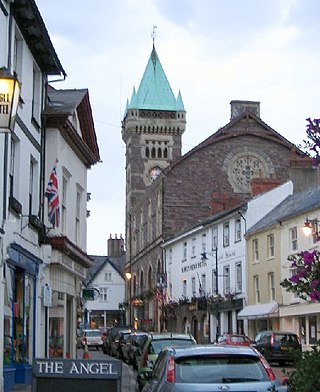
Abergavenny is a market town and community in Monmouthshire, Wales. Abergavenny is promoted as a "Gateway to Wales"; it is approximately 6 miles (10 km) from the border with England and is located where the A40 trunk road and the recently upgraded A465 Heads of the Valleys road meet.

Monmouth is a market town and community in Monmouthshire, Wales, situated on where the River Monnow joins the River Wye, two miles from the Wales–England border. The population in the 2011 census was 10,508, rising from 8,877 in 2001. Monmouth was the county town of historic Monmouthshire, although Abergavenny is the largest settlement and Monmouthshire County Council has its main offices at Rhadyr, just outside Usk. Monmouth is in the UK Parliament constituency of Monmouthshire and the Senedd constituency of Monmouth.

Monmouthshire is a county in the south east of Wales. It borders Powys to the north; the English counties of Herefordshire and Gloucestershire to the north and east; the Severn Estuary to the south, and Torfaen, Newport and Blaenau Gwent to the west. The largest town is Abergavenny, and the administrative centre is Usk.
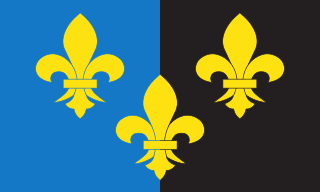
Monmouthshire, also formerly known as the County of Monmouth, was one of the thirteen historic counties of Wales in the south-east of Wales, on the border with England. Its area now corresponds approximately to the present principal areas of Monmouthshire, Blaenau Gwent, Newport and Torfaen, and those parts of Caerphilly and Cardiff east of the Rhymney River.

The Royal Monmouthshire Royal Engineers (Militia) is the most senior regiment of the British Army Reserve. The regiment was formed in 1539 during the reign of by King Henry VIII. The R Mon RE (M) became a militia unit in 1660 and then became a part of the Royal Engineers in 1877.

Monnow Bridge, in Monmouth, Wales, is the only remaining fortified river bridge in Great Britain with its gate tower standing on the bridge. Such bridge towers were common across Europe from medieval times, but many were destroyed due to urban expansion, diminishing defensive requirements and the increasing demands of traffic and trade. The historical and architectural importance of the bridge and its rarity are reflected in its status as a scheduled monument and a Grade I listed building. The bridge crosses the River Monnow 500 metres (1,600 ft) above its confluence with the River Wye.
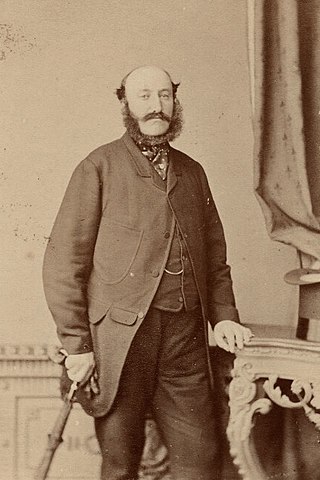
Henry Charles FitzRoy Somerset, 8th Duke of Beaufort, KG, PC, styled Earl of Glamorgan until 1835 and Marquess of Worcester from 1835 to 1853, was a British peer, soldier, and Conservative politician. He served as Master of the Horse, Member of Parliament for East Gloucestershire, and Lord Lieutenant of Monmouthshire.

John Allan Rolls, 1st Baron Llangattock, was a British landowner, Conservative Party politician, socialite, local benefactor and agriculturalist. He lived at The Hendre, a Victorian country house north of Monmouth.

The Monmouth Museum, previously known as The Nelson Museum and Local History Centre, was a museum in Monmouth, Monmouthshire, south east Wales. It featured a collection of artefacts associated with Admiral Horatio Nelson, and a local history collection. The museum was located in the Market Hall in the town centre. It was closed during the COVID-19 pandemic in the United Kingdom and did not re-open thereafter. In 2021 Monmouthshire County Council announced plans to move the museum collection to the Shire Hall in Agincourt Square. The five-year project, supported by the National Lottery Heritage Fund, will see a new museum open at the Shire Hall by 2027. The Market Hall site will be let as commercial premises.

The Shire Hall, Monmouth, Wales, is a prominent building on Agincourt Square in the town centre. It was built in 1724, and was formerly the centre for the assize courts and quarter sessions for Monmouthshire. The building was also used as a market place. In 1839–40, the court was the location of the trial of the Chartist leader John Frost and others for high treason for their part in the Newport Rising.

The Coleford, Monmouth, Usk & Pontypool Railway (CMU&PR) was a standard gauge railway of 16 miles (26 km) which ran from Monmouth to Little Mill, near Pontypool in Monmouthshire, Wales. It was intended to convey the mineral products of the Forest of Dean to the ironworks of South Wales, by connecting to the Newport, Abergavenny and Hereford Railway at Little Mill Junction. The NAHR made the onward connection over its Taff Vale Extension line. The CMU&PR intended to acquire the Monmouth Railway, actually a horse-operated plateway, and convert it to locomotive operation.
Monmouth Rowing Club is located on the banks of the River Wye in Monmouth, the county town of the historic county of Monmouthshire, Wales. The club is affiliated with the Welsh Amateur Rowing Association (WARA) and hosts several annually organised race events.
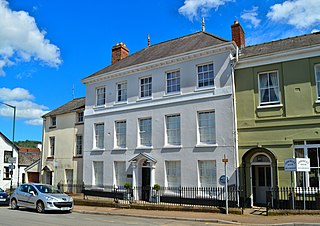
The Dispensary is a Georgian town house which is fairly typical of many town-centre houses in Monmouth, Wales, dating from the mid 18th century, but with early 19th-century additions. It stands in St James Square, opposite the Catalpa tree. The building was listed at Grade II on 27 June 1952.

John Etherington Welch Rolls was a High Sheriff of Monmouthshire, art collector, Deputy Lieutenant and Justice of the Peace. Rolls was President of, and co-founded the Monmouth Show.
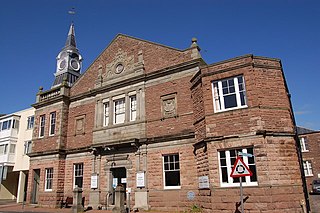
The Rolls Hall, Whitecross Street, Monmouth, Monmouthshire is a Victorian hall, now public library, donated to the town in celebration of Queen Victoria's Golden Jubilee by John Rolls, the future Lord Llangattock. It is a Grade II listed building as of 8 October 2005, and is one of 24 buildings on the Monmouth Heritage Trail.

Vauxhall Fields, also known as Vauxhall Meadows, are water meadows to the northwest of Monmouth town centre, Wales. The River Monnow borders the meadows on two sides. The meadows have generally remained free of development. The area has been prone to flooding on many occasions over the years.
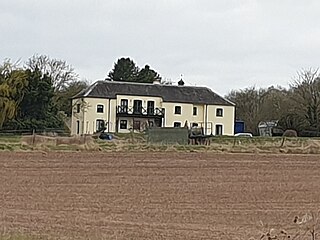
Croft-Y-Bwla is a country house and farm 1.5 miles (2.4 km) north-west of Monmouth, south-east Wales. The house was built around 1830 and was designed by the noted Monmouth architect George Vaughan Maddox. It has been listed as Grade II since 1974.

The Rolls family were substantial landowners and benefactors in and around Monmouth in south-east Wales. The ascent of the family to the aristocracy was through marriage. A prominent member of the family was Charles Stewart Rolls, who co-founded the Rolls-Royce car manufacturing company.

The Nelson Rooms is a grade II listed building in Monmouth, Monmouthshire, Wales. It is in the historic Glendower Street and Agincourt Street neighbourhood, within the medieval town walls. The building initially served as a gymnasium and was a gift from Lady Llangattock to the town of Monmouth. In 1924, after the benefactor's death, it reopened as the Nelson Museum, and showcased the collection of memorabilia related to Admiral Horatio Nelson that had been amassed by the baroness. The Nelson Museum moved to new quarters at the Market Hall in 1969. The former gymnasium and museum is now an apartment building.

Peter Alan Fox OBE is a British Conservative politician who is the Shadow Minister for Finance in the Senedd. Fox was Leader of Monmouthshire County Council from 2008 until May 2021, when he was elected as a Member of the Senedd (MS) for the Monmouth constituency.